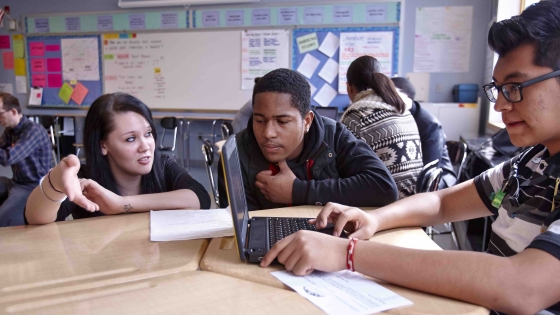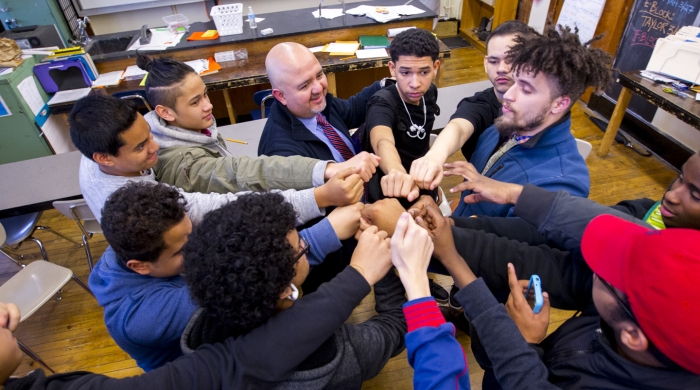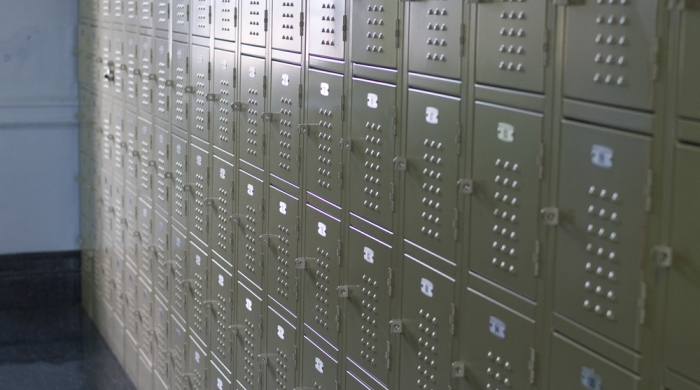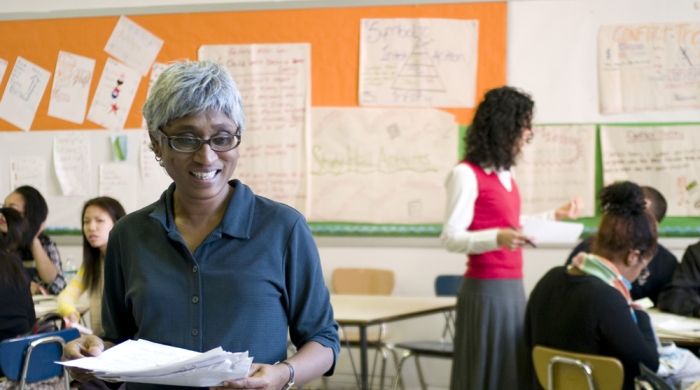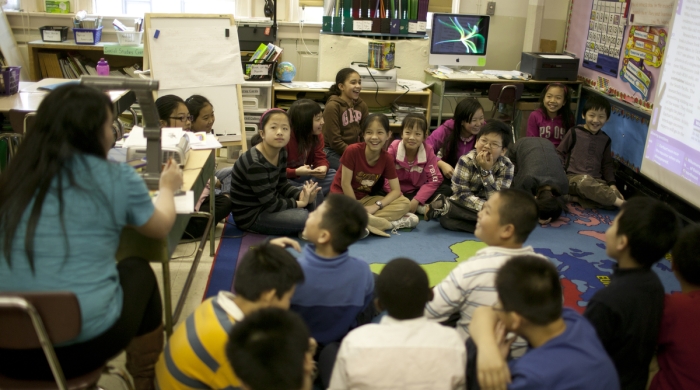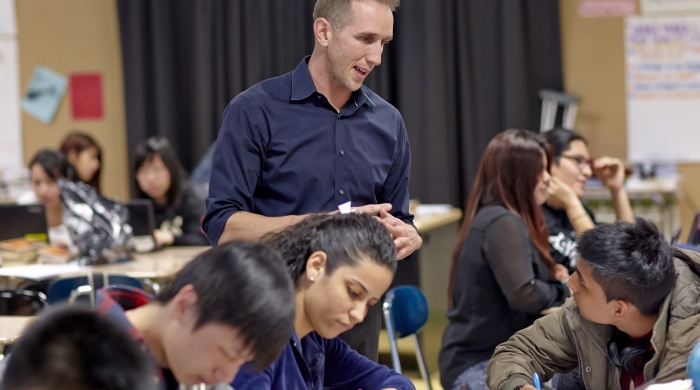
Featured Publications
All Publications
Expanding Computer Science Education for All
New York City’s CS4All initiative, launched in 2015, significantly expanded access to computer science (CS) education, tripling the number of participating schools and reaching nearly 170,000 students annually. This new Research Alliance report examines the initiative’s successes, as well as ongoing challenges, and highlights the need for continued efforts to ensure high-quality CS learning opportunities for all students.
High School Advising
In a landscape where college and career readiness is paramount, this new report delves into NYC high school students' experiences with school-based advising for postsecondary transitions. The findings highlight differences across students and schools, including the presence of stronger career-oriented support in schools with Career and Technical Education (CTE) programs.
Participation and Outcomes in Out-of-School Work-Based Learning
In the second report from the Research Alliance's study of ExpandED Schools’ STEM Options (ES Options) program, we examine the program’s implementation, as well as the outcomes of students who participated in 2023.
Career and Technical Education in Comprehensive High Schools
The second in our series on Career and Technical Education in New York City, this report focuses on 51 Comprehensive high schools that offer CTE alongside other educational options.
Educational Practices to Identify and Support Students Experiencing Homelessness
In partnership with EdResearch for Action, as well as scholars from Southern Methodist University, Utah State University, and University of Kentucky, this brief outlines evidence-based practices for supporting homeless students.
Recruiting and Retaining High School Students in Out-of-School Work-Based Learning
In the first report of two from the Research Alliance's study of ExpandED STEM Options, we examine student recruitment, enrollment, and retention for the 2022 cohort.
NYC as a Laboratory for Learning About Career and Technical Education
This report is one of several that will emerge from our ongoing study aimed at informing local and national CTE policy and practice. It focuses on 37 CTE-Dedicated high schools, which are structured to ensure that all enrolled students participate in a CTE Program of Study from 9th through 12th grade.
ASD Nest: Exploring Educators' Perspectives on an Innovative Model for Autistic Students
Prior to the Covid-19 pandemic, the Research Alliance conducted a small study aimed at understanding educators’ experiences in the ASD Nest program. Our findings provide useful insight into factors they see as important for implementing the model, challenges that may need to be addressed, and considerations for replicating ASD Nest in other schools and districts.
CS4All: Examining Equity
As part of the Research Alliance’s ongoing evaluation of CS4All, this report examines progress toward the initiative’s goals, including the extent to which schools are reaching all of their students with CS, as well as the extent to which participation is equitable for girls and Black and Latinx students—who have been starkly underrepresented in CS education and careers.
Policing and Educational Outcomes
This study uses data on more than 230,000 NYC students to examine the effects of neighborhood policing on high school graduation rates. The findings highlight starkly different experiences with policing across racial/ethnic groups and provide evidence about how these inequities shape students' educational trajectories.
Improving the Teacher Pipeline in the Bronx
In 2017, the New York City Department of Education launched the Teacher and School Leaders Bronx Human Capital Initiative (TSL). The Research Alliance undertook an evaluation to examine TSL’s impact on teacher and student outcomes.
Lessons Learned from the Maker Partnership
This report highlights key findings and lessons from our study of MPP and provides access to resources and materials designed for the project, including information about MPP’s approach to teacher professional development, descriptions of Maker instructional strategies, and sample lesson plans.
We're Not All Average: Reconceptualizing School Climate
What are we missing when we focus on the “average” student experience? How do students’ perceptions of school climate vary? And could a clearer picture of this variation inform efforts to develop more inclusive and equitable learning environments, within schools and across the system? (2021)
Design2Learn: Implementation and Impact Study
Design2Learn (D2L) is a NYC-based afterschool program aimed at increasing middle school students’ interest, engagement, and achievement in science. We examined D2L’s implementation, as well as its impact on various student outcomes.
Social-Emotional Learning and Academic Growth
This report describes a portion of work from an innovative SEL-focused research-practice partnership between the Student Success Network (SSN) and the Research Alliance for New York City Schools.
Blueprint for Advancing Equity in NYC Schools
The Research Alliance’s new policy brief outlines recommendations for how City and District leaders can take a more demanding approach to advancing equity, while sustaining the progress that has been made during the last 20 years.
Summer Meals for NYC Students
The Research Alliance conducted a series of in-depth focus groups to better understand potential barriers to participation in summer meals programs. This brief highlights insights from these focus groups, including parents’ sense of the benefits of summer meals programs, as well as their ideas for how these programs might be improved.
Building Teacher Capacity to Interrupt Racism in Schools
This report presents findings on two programs of the Center for Racial Justice in Education—one of a growing number of organizations, in NYC and around the country, working to combat racism in schools. (2020)
Mentoring, Technology, and Social and Emotional Learning
The iMentor College Ready Program combines school-based mentoring with technology and aspects of whole school reform in an effort to boost students’ college readiness. This final report from our evaluation assesses the implementation of iMentor and its impact on students’ social and emotional learning (SEL), academic outcomes, college going activities, and transitions to college. (2020)
Identifying and Supporting Students Experiencing Homelessness
This brief is one in a series aimed at providing K-12 education decision makers and advocates with an evidence base to ground discussions about how to best serve students during and following the novel coronavirus pandemic. In this brief, we examine what schools can do to best support students experiencing homelessness amid the added vulnerability they have faced due to the pandemic. (2020)
Exploring the Evidence on Virtual and Blended Learning
We recently updated our overview of research and practical guidance on remote and blended instruction. We also highlighted the need for more rigorous evidence and outlined data that should be collected, analyzed and shared.
Special Education in New York City
Nearly one in five New York City public school children is diagnosed with a disability, making them eligible to receive special education services. This brief presents a snapshot of the landscape of special education in New York City, exploring the background characteristics of students who have an Individual Education Plan (IEP), the settings in which they are served, and their engagement with school. (2019)
Aggressive Policing and Academic Outcomes
While NYC’s approach to policing has changed since 2012—including the end of “stop and frisk” policies deemed racially discriminatory by the courts—many young people of color, in NYC and across the country, continue to live in communities with a heavy police presence. Yet, to date, there has been relatively little research on how this impacts students’ educational outcomes. In this brief, we present findings from a new study and highlight their implications for policy and practice. (2019)
Better Evidence for Better Schools
In 2008, a diverse group of New York City leaders—including representatives from the NYC Department of Education, the teacher and administrator unions, the philanthropic and business communities, and New York University—came together to establish the Research Alliance for New York City Schools. (2019)
Homelessness in NYC Elementary Schools
Our study examines the experiences of homeless elementary students in New York City, and illuminates important findings about this vulnerable group of children. We also highlight educator perspectives on the challenges associated with serving large numbers of homeless students, as well as practices to improve students’ educational experiences.
Training Youth Development Practitioners
Our new brief draws on focus groups and interviews with SSN Fellows (as well as colleagues at their home organization) to highlight several key lessons for using the continuous improvement (CI) approach in efforts to boost students’ social emotional learning skills. (2018)
New Directions for Data Use in Schools
This brief highlights findings from our study that examined how NYC teachers were using data to inform their classroom practice, school support of this effort, and to what effect. We share key findings about successful data use in teaching and propose several new directions that educators can take to help make the most of data in schools.
Persisting Students
Exploring the Pathways and Outcomes of Students Who Don't Graduate in Four Years, But Remain Enrolled in NYC High Schools. The brief uses mixed methods to explore who persisting students are, how they fall off track, which schools they attend, and the supports that students and educators see as most important for helping persisting students succeed. (2018)
Computer Science in New York City
This report includes a summary of CS4All’s key goals and strategies; a broad look at CS education and training in the City (including programs that are the result of CS4All’s first two years of implementation, as well as preexisting efforts); an exploration of teachers’ responses to CS4All PD; and considerations for the ongoing development of the initiative. (2018)
The Expanded Success Initiative
This report synthesizes findings from the Research Alliance’s four-year evaluation of ESI, including its impact on school culture and students' opportunities and outcome.
Redesigning the Annual NYC School Survey
This collection and policy brief highlight key lessons from the highly collaborative NYC School Survey redesign process between the Research Alliance and the New York City Department of Education. This work also demonstrates how a robust research-practice partnership can inform school district decisions and create useful measurement tools for the field. (2018)
iMentor’s College Ready Program
The report examines the program's impact on a variety of outcomes (e.g., experiences and attitudes related to college preparation, attendance, GPA, on-track status), and updates our analysis of the program’s implementation across schools. The report also begins to explore the relationship between students’ engagement with key components of the College Ready Program and their outcomes. (2017)
Guide for Educators: Learning Out Loud
This guide outlines two programs developed at Brooklyn Preparatory High School and the Academy for Young Writers that were designed to elevate student voices. This guide was developed as part of our ongoing evaluation of ESI, an effort to improve college and career readiness among Black and Latino young men in 40 NYC high schools. (2017)
New York City Goes to College
This report provides an in-depth look at high school students’ pathways into and through college, revealing large improvements in college access, but also highlighting persistent differences in outcomes for historically underrepresented groups of students. It uses a new four-part framework – access, persistence, efficiency, and equity – to examine students’ pathways. (2017)
More Than an Application
How Two NYC High Schools Work with Students and Parents on the Road to College. This practice guide draws on the experiences of two New York City high schools that built multi-layered supports for students and their families on the pathway to college. The schools aim to address social, emotional, and academic needs for students during high school— beginning in 9th grade—and to provide very clear bridges to life beyond high school graduation. (2017)
The NYC Partnership for College Readiness and Success
The most significant result from the Partnership's work has been the creation of a unique Dataset, distinguished by its size, its depth of available individual-level data, and its longitudinal capabilities. Drawing on these data, the Research Alliance and CUNY have published a series of working papers exploring NYC students' pathways into and through college.
Focus on Mentee-Mentor Relationships
The 10th Grade Implementation of iMentor's College Ready Program. This report provides a detailed description of the four key components of the iMentor College Ready Program and assesses the implementation of these program elements for 10th graders. It also assesses how specific types and quantities of interaction between mentees and mentors are associated with the closeness of their relationships. (2016)
Bridging The Gap
This report focuses on four phases of work involved in bringing ed-tech companies and the users of their products together: defining a problem; selecting users and ed-tech companies; implementing pilot-based initiatives; and evaluating products. (2016)
Strategies for Improving School Culture
This report draws on interviews, focus groups, and case studies to highlight ESI schools’ efforts to strengthen school culture in four key areas: developing culturally relevant education; adopting restorative approaches to discipline; promoting strong relationships in school; and providing early support for postsecondary goals. (2016)
Creating Supportive Bonds of Brotherhood: A Guide for Educators
Produced by the Research Alliance as part of our evaluation of the City’s Expanded Success Initiative (ESI), this guide highlights ESI schools' efforts to build relationships and promote a sense of brotherhood and camaraderie among male students of color.
Culturally Relevant Education: A Guide for Educators
This guide explores how ESI schools enacted culturally relevant education, which strives to empower students by incorporating their cultures, backgrounds, and experiences into the school environment and classroom activities.
Early Exposure to & Preparation for College: A Guide for Educators
This guide details a number of strategies that ESI schools used to help students identify postsecondary goals, starting in 9th grade, and to support them in taking concrete steps toward achieving these goals.
Improving Academic Readiness for College: A Guide for Educators
This guide provides examples of how ESI schools attempted to bolster academic supports available to their students and increase the academic rigor of their classes.
Preparing for Evaluation
This report describes an evaluability assessment conducted by the Research Alliance on behalf of the Teagle Foundation. The Foundation contracted the Research Alliance to explore the feasibility of a variety of approaches to evaluating its College-Community Connections initiative, which funds partnerships between community-based organizations and universities, aimed at promoting college access and success among talented but underrepresented students in NYC. (2016)
Schools as Organizations
Could strengthening key aspects of a school's climate actually improve teaching and learning? This study examines how changes in school climate were related to changes in teacher turnover and student achievement in 278 NYC middle schools, between 2008 and 2012. (2016)
Connecting Teachers and Ed-Tech Developers
This report presents findings from our study of the NYC DOE's "Gap App" challenge and pilot program, which solicited new ed-tech tools aimed at solving a specific learning challenge. A number of the tools were then piloted in NYC public schools. The report describes the design of the challenge, the implementation of the pilot, and provides a set of lessons that may inform similar projects. (2016)
High School Closures in New York City
Between 2002 and 2008, 29 low-performing high schools were designated for closure in New York City. This report presents the results from the first rigorous study of the impact of these closures on students’ academic performance, attendance, and mobility. (2015)
Bringing Together Mentoring, Technology, and Whole School Reform
This is the first report from our evaluation of iMentor's College Ready Program, an intensive, four-year intervention that aims to help students develop the knowledge, behaviors, and skills they need to reach and succeed in college (2015)
Changing How High Schools Serve Black and Latino Young Men
This report presents our findings from Year 2 of the Expanded Success Initiative (the 2013-2014 school year), drawing on interviews and focus groups with staff at ESI schools and a set of matched comparison schools, a student survey, and an analysis of student achievement data. (2014)
Pathways to an Elite Education
This brief examines NYC students’ pathways from middle school to matriculation at one of the City's elite specialized high schools, and simulates the effects of various admissions criteria that have been proposed as alternatives to the current test-based admissions policy (2015)
Better Evidence for Better Schools
To date, the Research Alliance has undertaken more than 20 major studies. What have we learned from this work? What evidence have we amassed that can help City leaders better allocate resources, more meaningfully assess student progress and school performance, and ultimately serve students, families, and communities more effectively? And finally, what are the pressing issues in education policy and practice that we hope to tackle next? (2014)
New York City Goes to College: A First Look
This brief reports the first set of findings from a unique new dataset that tracks multiple cohorts of NYC students from 9th grade through college. It describes recent patterns of college enrollment, persistence, and completion for NYC students, and begins to explore factors that may affect their college outcomes. (2014)
Inside Success
This report provides a rare and textured look at the work of 25 highly effective high schools in NYC. Drawing on interviews and focus groups, the report highlights features that educators see as most responsible for their school’s success. The findings paint a picture of how these features were developed in practice. They also shed light on challenges the schools face, as they attempt to sustain their impact over time. (2014)
Digital Collaboration and Classroom Practice
ARIS Connect is a district-developed tool designed specifically to help educators improve their practice by sharing resources, posting questions, and giving one another feedback, both within schools and across the district. Our study investigated how educators perceive and use ARIS Connect and other so-called “Web 2.0” tools for sharing and collaborating. (2014)
Promising Opportunities for Black and Latino Young Men
This report presents a rich picture of the roll out and early implementation of the Expanded Success Initiative, drawing on more than 100 interviews and focus groups with educators in ESI schools and with members of the NYC Department of Education’s ESI team. The report examines challenges schools experienced during Year 1 of the initiative, as well as changes in school practice that hold promise for reaching ESI’s goals. (2014)
Moving the Needle
This report examines the trajectory of Black and Latino young men on their path to college, zeroing in on points along that path where schools might provide more effective support. The report describes college-related outcomes and other indicators that help predict college readiness for Black and Latino male students over time, and discusses key contextual factors that underlie these educational outcomes. (2013)
Strengthening Assessments of School Climate
Strengthening Assessments of School Climate outlines a set of broader lessons that have emerged from our work, which can provide guidance to the growing number of cities and states around the country that are implementing school survey efforts. (2013)
High School Choice in NYC
The New York City Department of Education’s recent efforts to improve high schools have in large part depended on a policy of choice, which enables families to select a school that they believe will best meet their child’s needs. This report examines the high school choices and placements of New York City’s lowest-achieving students, and assesses how these schools compare to those of their high-achieving peers. (2013)
The Condition of NYC High Schools
Until the turn of the 21st century, high school graduation rates in New York City hovered at or below 50 percent, much lower than state and national averages. There was widespread agreement about the need to reform the City’s high schools and produce better results for students. This paper presents an independent analysis of how the high school landscape changed in New York City between 1999 and 2011 and, importantly, the extent to which key student outcomes improved during that time. (2013)
Who Stays and Who Leaves?
This paper synthesizes findings from the Research Alliance’s investigation of teacher turnover in New York City’s public middle schools. These years are widely recognized as a critical turning point for students, and the NYC Department of Education (DOE) is pursuing a range of middle school improvement initiatives. The stability of the middle school teaching force has the potential to facilitate or complicate these efforts, yet there have been few studies of the rates and patterns of teacher turnover in the City’s middle schools. (2013)
Usage Patterns and Perceptions of the Achievement, Reporting and Innovation System (ARIS)
This report offers the first systematic examination of actual usage of New York City’s Achievement Reporting and Innovation System (ARIS), a comprehensive data system designed to put student information within easy reach of school administrators and teachers. The findings suggest that ARIS has been used successfully as a school-wide planning tool, but was less valuable as a direct aid to classroom instruction. (2012)
Assessing the Early Impact of School of One
School of One (SO1) is an innovative, technology-enhanced math program that seeks to “meet students where they are,” by creating individual learning plans, offering multiple teaching strategies, and using daily assessments to monitor progress and adapt lessons as needed. This report evaluates SO1’s impact on students’ state test scores during the first year of school-wide implementation in three New York City middle schools. (2012)
Thoughts of Leaving
This report explores the conditions under which middle-school teachers in New York City leave their schools, and the consequences of this turnover. The focus on middle schools stems from the widely-held view that the middle grades are a critical turning point in the lives of children, and that many New York City schoolchildren lose academic momentum in these grades, setting them on trajectories of failure as they move towards high school and life beyond it. (2012)
Navigating the Middle Grades
In this study, we investigate whether and how students' achievement and attendance change between grades four and eight and identify moments during this period when students' achievement and attendance suggest they will struggle to graduate from high school on time. (2011)
Learning from “Turnaround” Middle Schools
In New York City and around the nation, there is intense interest in the question of what it takes to turn around a low-performing school. This study focused on two sets of initially low-performing NYC middle schools. The first group (the “turnaround schools”) exhibited significant growth in academic performance between 2006 and 2010, while the other group saw minimal growth or remained stagnant during the same period. (2012)
The Middle School Teacher Turnover Project
This report presents findings from the first of three components of a mixed-methods study of middle school teacher turnover in New York City. Our findings suggest an exodus of newly-arrived teachers from middle schools, and they raise questions for future research about the causes, consequences, and implications of teacher turnover. The remaining two components of the Research Alliance’s larger study – a survey and a case study analysis – will investigate these and other questions. (2011)
Learning from New York City’s Portfolio Strategy
On November 18, 2010, the Research Alliance, in partnership with the Future of Children Journal, hosted a research colloquium entitled Learning from New York City’s Portfolio Strategy: How Policy and Practice can Inform Research. We invite you to read more about the research colloquium and the research questions that were proposed to inform high school improvement initiatives in New York City. (2010)
Children First and Student Outcomes: 2003-2010
The chapter addresses the ultimate goals of the reforms instituted under the banner of Children First: improved student performance and higher graduation rates. To date, the field has lacked a rigorous and independent analysis of the extent to which the city’s improved test scores and graduation rates reflect Children First effects per se or are artifacts of prior reform efforts or of other external influences occurring during the Children First era (2003-2010). This chapter seeks to fill that gap and provides compelling evidence of positive effects on student test scores and graduation rates. (2010)
Inaugural Paper Series
Presented at the inaugural conference of the Research Alliance for NYC Schools, New York, October 2007.
Schwartz, Amy Ellen., Rubenstein, Ross., and Stiefel, Leanna, 2007
Why Do Some Schools Get More and Others Less?
An Examination of School-Level Funding in New York City.
Boyd, Donald., Grossman, Pamela., Lankford, Hamilton, Loeb, Susanna., and Wyckoff, James H., 2007
Who Leaves?
Teacher Attrition and Student Achievement.
Easton, John Q., and Roderick, Melissa, 2007
Developing New Roles for Research in New Policy Environments .
The Consortium on Chicago School Research.
Pallas, Aaron M., and. Riehl, Carolyn J., 2007
The demand for high school programs in New York City .
Note: If you have problems downloading any of our reports, please email research.alliance@nyu.edu

